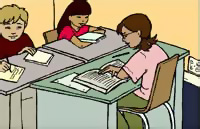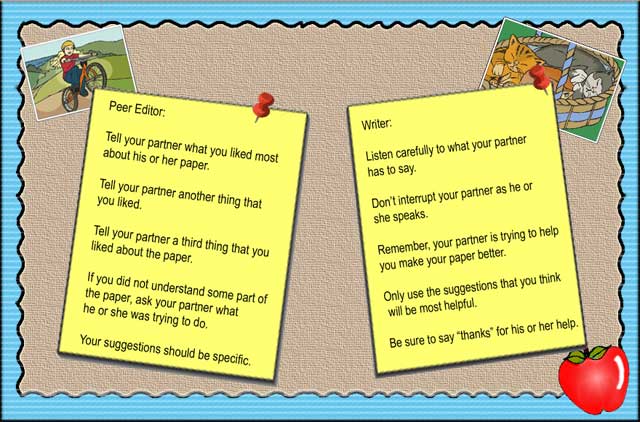Which Of The Following Takes Place During The First Phase Of The 3-x-3 Writing Process?
What could Ms. Lin do to help her students learn to write persuasive essays?
Page 3: Elements of the Writing Process
 Teaching composition skills to students involves much more than simply instructing them in the elementary mechanics of written language or explaining the basic components of a paragraph. Mechanics and elementary knowledge are necessary, of course, but teaching these skills alone does not usually lead to students writing more organized essays. Instead, students must understand the writing process and learn how to integrate their knowledge and ideas into their essays. The writing process consists of elements that help a writer to develop text that is reflective, clear, and coherent. The following section will discuss four elements of the writing process:
Teaching composition skills to students involves much more than simply instructing them in the elementary mechanics of written language or explaining the basic components of a paragraph. Mechanics and elementary knowledge are necessary, of course, but teaching these skills alone does not usually lead to students writing more organized essays. Instead, students must understand the writing process and learn how to integrate their knowledge and ideas into their essays. The writing process consists of elements that help a writer to develop text that is reflective, clear, and coherent. The following section will discuss four elements of the writing process:
- Planning
- Organizing
- Writing
- Editing and revising
Planning
Planning refers to the use of a deliberate and organized approach to tackling a writing task and includes a writer's first thoughts or basic ideas about the topic. Students who struggle with writing generally do not plan ahead; rather, they compose their text as they write. During the planning process, students should ask themselves who their readers will be and what the essay's purpose is. Planning ahead helps students to form more complete thoughts and to produce more cohesive essays.
Organizing
 It is not at all unusual for students to have difficulty selecting the important information from everything they brainstormed during the planning stage. Students often also have difficulty knowing just how to use that information in their essays. Therefore, once students have formulated their writing plans, it is time to organize their thoughts. During this step of the writing process, students will:
It is not at all unusual for students to have difficulty selecting the important information from everything they brainstormed during the planning stage. Students often also have difficulty knowing just how to use that information in their essays. Therefore, once students have formulated their writing plans, it is time to organize their thoughts. During this step of the writing process, students will:
- Elaborate on the ideas that were generated for them during the planning process
- Determine what information, if any, is still needed in order to fill in the gaps
- Gather that information
- Arrange their ideas so that they flow together and make sense
Writing
In the initial writing stage, students will produce a rough draft incorporating the ideas that were generated during the planning stage and subsequently arranged in the organization stage. This initial writing phase requires students to coordinate ongoing cognitive demands, such as:
- Combining planned ideas with new thoughts
- Remembering the purpose of the paper
- Using appropriate grammar rules
- Considering the intended audience
Editing and Revising
Tip
Instruct students to write their drafts on colored paper to help them remember that this is not a final product.
Though the editing and revising stages are usually thought of as one step, they are, in fact, two interlinked steps. It is important for students to distinguish between the editing and revising steps in the writing process. For example, students need to learn that writing is a process that requires them to apply editing marks as they revise their essays. The revising stage, however, may also require changes in content or organization.
Editing
During the editing stages of the writing process, students will:
- Check their grammar
- Check their spelling
- Check their punctuation
- Ask whether their ideas are clear
- Ask whether their purpose has been met
Other than teacher-editing, there are two ways editing can occur: self-editing and peer-editing.
Self-editing: When a student edits his or her own paper, he or she should read it aloud and listen to its flow and choice of words. He or she should also listen to hear whether any words have been left out. Keep in mind that it may be difficult for some students to identify flaws during the self-editing process.
Peer-editing: By contrast, when a peer edits a paper, he or she may be able to more easily point out areas that are difficult to understand. Collaboration with a peer allows a student to gain additional insight through examining his or her own peer-edited paper, editing the peer's paper, and sharing ideas and opinions.
 When teaching them a collaborative method for editing, it is important to tell students how to work through the editing process. Students should be taught how to provide feedback with specific constructive phrases, including giving praise and pointing out parts of the paper they really liked. This will help ensure that the collaborative editing process is a positive experience for both students in each pair.
When teaching them a collaborative method for editing, it is important to tell students how to work through the editing process. Students should be taught how to provide feedback with specific constructive phrases, including giving praise and pointing out parts of the paper they really liked. This will help ensure that the collaborative editing process is a positive experience for both students in each pair.
The bulletin board below displays example statements that students can be taught to use when they edit a peer's paper.

Adapted from S. Graham (personal communication, September 20, 2006)
A bulletin board holds two papers. One is a transcript entitled "Peer Editor." The other is a transcript entitled "Writer."
Peer Editor:
- Tell your partner what you like most about his or her paper.
- Tell your partner another thing that you liked.
- Tell your partner a third thing that you liked about the paper.
- If you did not understand some part of the paper, ask your partner what he or she was trying to do.
- Your suggestions should be specific.
Writer:
- Listen carefully to what your partner has to say.
- Don't interrupt your partner as he or she speaks.
- Remember, your partner is trying to help you make your paper better.
- Only use the suggestions that you think will be most helpful.
- Be sure to say "thanks" for his or her help.
Revising
As was discussed above, it is important for students to distinguish between the editing and revising stages. Revising allows the writer to consider the content, quality, and clarity of his or her composition. When students revise their work, they should look at the editing suggestions made by their teachers and peers, and that they themselves arrived at during self-editing, to determine how the edits and comments can help to improve their papers. For example, they might:
- Utilize comments and suggestions
- Rearrange the order of the text
- Make corrections
- Expand ideas
- Rewrite their papers
 Students may or may not use all of the comments that they receive. Once students have decided which suggestions to use, they should determine how to incorporate and expand on these new ideas. Before turning in a final product, students should repeat this process at least one more time to ensure that the new ideas have helped to meet the purpose and have improved the clarity of their papers.
Students may or may not use all of the comments that they receive. Once students have decided which suggestions to use, they should determine how to incorporate and expand on these new ideas. Before turning in a final product, students should repeat this process at least one more time to ensure that the new ideas have helped to meet the purpose and have improved the clarity of their papers.
![]()
Which Of The Following Takes Place During The First Phase Of The 3-x-3 Writing Process?
Source: https://iris.peabody.vanderbilt.edu/module/pow/cresource/q2/p03/
Posted by: huttonandless00.blogspot.com



0 Response to "Which Of The Following Takes Place During The First Phase Of The 3-x-3 Writing Process?"
Post a Comment